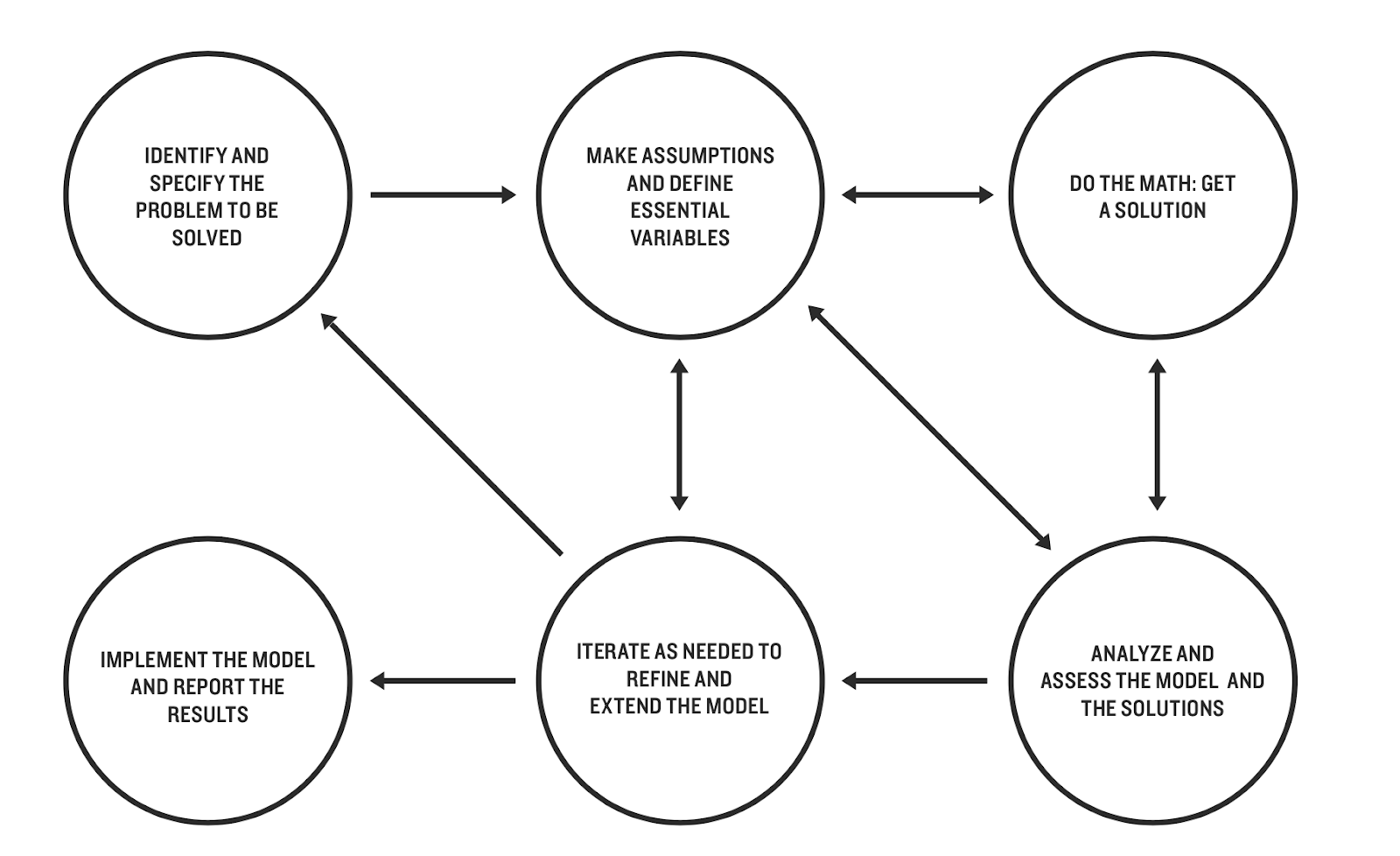Math Modeling
On Saturday, April 23rd, we'll delve into Math Modeling and its impact on the real
world! See you there!
View the Video Here

What is Math Modeling?
Simon Frasier University describes math modeling as “a representation in mathematical terms of the behavior of real devices and objects”. In other words, math modeling is anything that uses math to describe or predict a real world behavior. For example, predicting how high a ball will go once you throw it using an equation would be a math model. So would be describing the amount of cookies each person would get in a picnic. So is calculating how much grocery you can buy within your budget. Math modeling is pervasive and important.
Why should I be excited about Math Modeling?
Chances are, you’ll encounter math modeling at some point in your life. Math modeling plays an integral role in a lot of the things we do, whether it be through budgeting, shopping, or discovering the next vaccine. Even more exciting, math modeling is at the forefront of hundreds of STEM fields. Interested in knowing how many habitable planets exist in the galaxy? What about how stock market changes affect the economy? Or, how climate change will affect coastal life? How about engineering buildings to withstand earthquakes? Our society is in dire need for scientists and engineers, and math modeling is a central part of both. With math modeling principles, you can answer all of these questions and more.
What do Math Modelers do?
As you’ve probably guessed, anyone can be a math modeler. In fact, everyone is a math modeler in some way in learning important skills like handling money, lunch, or time management. Here are examples of three different STEM fields where math modeling can be used: Ecology, Transportation, and Machine Learning.
Ecologists are scientists who study the relationship living things have to their environment. They use math modeling to ask questions like: how will increases in human population affect our environment? How will the loss of an endangered species affect its ecosystem? How many marine animals can we expect to ingest ocean pollutants in the Gulf of Mexico?
Transportation researchers study a wide range of topics related to aviation and path planning. They use math modeling to ask questions like: how can we efficiently plan train routes so that passengers can get to their destinations fastest? Or, how do we find our airplane altitude if we only know air pressure?
Machine learning is a subdivision of artificial intelligence and math modeling trying to understand how computers can learn from data. Machine learning scientists ask questions like: How can a computer differentiate between a bird and a cat? How can we find mathematical patterns in MRI scans to better diagnose brain disease?
How can I use math modeling?
Math modeling is based on the same principles of the Scientific and Engineering Method, which are centrals to all scientific (and often nonscientific) disciplines. This method is based on six essential steps (shown in the figure below). All of this stuff is also written up in a math modeling cheat sheet here.

The first step is to identify the problem. First, write a clear problem statement. Usually, its helpful to draw a diagram of the situation as well. Once you understand the problem clearly, outline what you would define as a succesful solution. Are you looking for a number answer? Or, are you using your model to support a recommendation? Find data and research relevant to the problem statement and your solution format.
Next, define your assumptions. Identify all of the variables that would affect your decision. Decide which variables you want to consider for your solutions. Out of the variables you want to consider, which do you want to change, and which can you set to a constant (a single number that doesn’t change)?
You can “do the math” in several different ways. You can find or simulate data that uses the variable(s) that you want to change. Or, brainstorm how the variables you defined should change (linearly? exponentially?) and create an equation to reflect this. There are so many ways to approach these problems, and the more creative you are, the better!
Now, analyze your model. Reflect on the answers you found in your model. How do they compare to real-life data? What did your model do right or wrong, and why? If you made more than one solution, compare them to each other. If you have metrics that to measure the effectiveness of your model (correlation coefficients, slopes, etc.), now is the time to use them.
We're about halfway to our final solution now! A large portion of math modeling is iteration and refining your model. Now that you’ve analyzed your results, look back at your model. How could you change it to better or more realistically answer the problem statement? Is there a way you can expand your model to include more variables? Try it! Try new solution ideas, and repeat steps 1-4 for them.
Lastly, implement your model and draw conclusions. Decide on the model you’d like to move forward with, and test it out on the given data/scenario, or a scenario that you think would reflect the problem statement. Write it up in the paper! The paper template here is a good start. Remember to cite your sources.
Remember, all of these steps don't have to follow each other! From the figure, you can see that there are several ways of finding a solution. Also, because there is no best answer to most given real world problem, and there is no best answer for any math problem either. Your solution is designed for your assumptions, variables, and constraints. Keep this in mind while you try out the challenge, and happy modeling!
What is the Gas Station Problem?
In the gas station problem, we use math modeling to assess the right gas station to go to. Say that you’re driving home from school, and can choose between a more expensive gas station near you, and a cheaper one farther away. Which do you go to? Of course, this all depends on the situation, if you need to go somewhere, etc. We go more into depth on how math modeling works and present our own solution in the video, but our solution is not the only one, nor is it the most creative and best solution! It’s just an example to show how math modeling works. We’ll update this page with our problem and sample solution links, as well as helpful resources!
Helpful Resources
About Math Modeling
Simon Frasier University: Math Modeling, What is Math Modeling?
Gas Station Problem
We’ll update this soon!
Additional Resources
Presentation Slides, Presentation Handouts, Presentation Recording
Video Citations
We'll update this section soon!
Glossary
- Ecology: the study of the interaction between living things and their environment.
- Intersection: (in context) the common areas between two fields.
- Machine learning: the study of autonomous computer learning.
- Mathematical terms: parts of a math equation.
- Model: a system used to describe or predict a real world process.
- Transportation: the study of how vehicles move, path planning, and necessary components
Video Citations
Images Used in Our Video
Websites Used for Our Presentation
